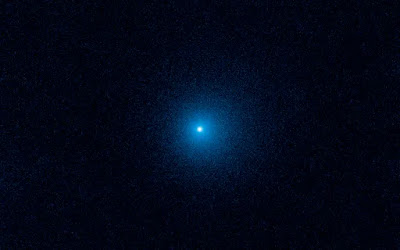The size of the comet designated C/2017 K2 (PanSTARRS) and dubbed K2, is predicted to be between 18 and 100 miles. NASA astronomers anticipate that its closest approach to Earth will occur on July 13, with the best visibility occurring on July 14.
In May of 2017, the Hubble Space Telescope identified the K2 comet between the orbits of Saturn and Uranus, around 2.4 billion kilometers from the sun.
NASA said that it was the furthest a comet has ever entered the planetary zone of the solar system. It is thought that the K2 comet formed in the Oort Cloud, a spherical layer of frozen particles with a temperature of -440 degrees Fahrenheit. The Oort Cloud is situated in the solar system's most distant area.
NASA scientists believe that the majority of long-period comets—meteors that take more than 200 years to circle the sun—come from the Oort Cloud.
The ice-and-dust comet the size of a city may have been gravitationally evicted from the Oort Cloud, starting a journey of millions of years that includes a brief visit to Earth.

In 2017, Hubble captured photographs of K2 when it was 1.5 billion miles from the Sun, well outside Saturn's orbit. Even at this great distance, sunlight is warming the icy comet, resulting in a coma that is 80,000 miles wide and encircles a compact, solid nucleus. NASA/ESA/D. Jewitt (UCLA)
Despite the comet's enormous size, it may first be difficult to notice. On July 13, it will make its closest approach to Earth, but will still be around two Earth-sun distances away. Quanzhi Ye, a comet-specializing astronomer at the University of Maryland, said that the comet would have been visible to the naked eye if it had arrived a half-year sooner or later.
Using a small telescope or binoculars is your best option for seeing K2 up close. At around 11 p.m. EST on July 14, you should look for a faint patch of light that is probably the comet's tail.
If you miss it, though, the comet will be visible via a telescope in the Northern Hemisphere until September when it approaches the sun at the end of the year. The K2 comet will be streamed live on Thursday at 6:15 p.m. EST.
The supermoon will also be visible from July 13 evening to July 14 morning. The Virtual Telescope Project will begin live-streaming the event on Wednesday at 3 p.m. EDT.
Because the moon will be at its brightest, it may be difficult to see fainter celestial objects, such as the K2 comet and summer stars, without the proper telescope.
Reference(s): Space.com, Virtual Telescope Live
In May of 2017, the Hubble Space Telescope identified the K2 comet between the orbits of Saturn and Uranus, around 2.4 billion kilometers from the sun.
NASA said that it was the furthest a comet has ever entered the planetary zone of the solar system. It is thought that the K2 comet formed in the Oort Cloud, a spherical layer of frozen particles with a temperature of -440 degrees Fahrenheit. The Oort Cloud is situated in the solar system's most distant area.
NASA scientists believe that the majority of long-period comets—meteors that take more than 200 years to circle the sun—come from the Oort Cloud.
The ice-and-dust comet the size of a city may have been gravitationally evicted from the Oort Cloud, starting a journey of millions of years that includes a brief visit to Earth.

In 2017, Hubble captured photographs of K2 when it was 1.5 billion miles from the Sun, well outside Saturn's orbit. Even at this great distance, sunlight is warming the icy comet, resulting in a coma that is 80,000 miles wide and encircles a compact, solid nucleus. NASA/ESA/D. Jewitt (UCLA)
Despite the comet's enormous size, it may first be difficult to notice. On July 13, it will make its closest approach to Earth, but will still be around two Earth-sun distances away. Quanzhi Ye, a comet-specializing astronomer at the University of Maryland, said that the comet would have been visible to the naked eye if it had arrived a half-year sooner or later.
Using a small telescope or binoculars is your best option for seeing K2 up close. At around 11 p.m. EST on July 14, you should look for a faint patch of light that is probably the comet's tail.
If you miss it, though, the comet will be visible via a telescope in the Northern Hemisphere until September when it approaches the sun at the end of the year. The K2 comet will be streamed live on Thursday at 6:15 p.m. EST.
The supermoon will also be visible from July 13 evening to July 14 morning. The Virtual Telescope Project will begin live-streaming the event on Wednesday at 3 p.m. EDT.
Because the moon will be at its brightest, it may be difficult to see fainter celestial objects, such as the K2 comet and summer stars, without the proper telescope.
Reference(s): Space.com, Virtual Telescope Live


Post a Comment